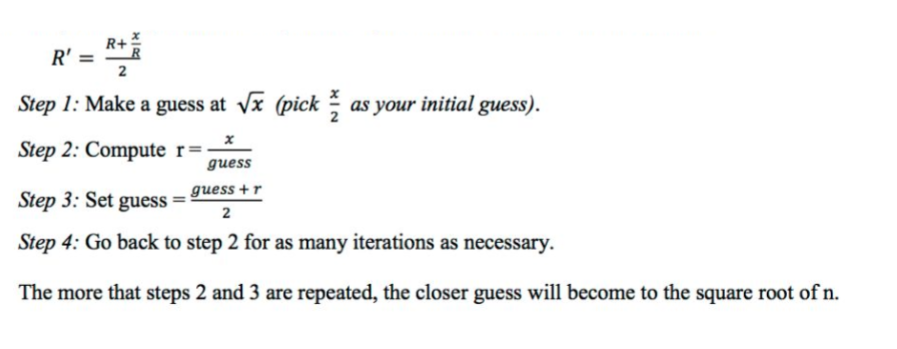Question
Implement this in C++ Part 1 You must first modify the Babylonian square-root estimation algorithm discussed in class. At the moment, the algorithm runs for
Implement this in C++
Part 1 You must first modify the Babylonian square-root estimation algorithm discussed in class. At the moment, the algorithm runs for a finite number of iterations and stops. This means that for a number like, say, 3, where the initial guess starts out close to the actual answer (1.5 vs 1.732. . . ) the accuracy will be extremely good. However, for much larger numbers where this is not the case,the accuracy will become disproportionately poorer. You will need to create a version of the algorithm which takes in two numerical inputs-Sis the number to take the square root of, and the other is an value which determines how accurately you want to approximate S. Instead of running for a finite number of iterations, the algorithmshould run for as long as it takes for the change to the estimate to fall below, and only thenoutput the result. Part 2 This part involves implementing anewsquare-root computation algorithm, sometimes called New-tons Method (based on the Babylonian method). This method finds the reciprocal square root ofS(that is,1S), which can then be used to find the desired S with the multiplication S=S1S(1) procedure Newton(S) guess2/S while condition 3aguess/2 b3Sguess guessab return Sguess This method can also theoretically run forever, continuing to refine its estimate, so you should also modify it to ask the user for avalue and run conditionally on the update step changing guess by more than (that is, stopping when the update step changes guess by less than ).
Part 3 Finally, you may notice that for numbers where the initial guess is sufficiently far away from theactual square root (particularly very small numbers, like 0.01), the algorithm in Part 2 never converges but in fact diverges- the changes in guess get bigger and bigger, and move it farther andfarther away from 1S. Implement logic to detect this (we will say that the algorithm has started to diverge if the difference between guesses increases for two consecutive iterations- in fact thereare cases where the difference will increase and then settle down again, but we dont need to worryabout those right now), stop iterating, and print out an error message.

^^ This is the babylonian method
Step 1: Make a guess at Vx (pick Step 2: Compute r= as your initial guess). guess Step 3: Set guess = guess + 2 Step 4: Go back to step 2 for as many iterations as necessary. The more that steps 2 and 3 are repeated, the closer guess will become to the square root of nStep by Step Solution
There are 3 Steps involved in it
Step: 1

Get Instant Access to Expert-Tailored Solutions
See step-by-step solutions with expert insights and AI powered tools for academic success
Step: 2

Step: 3

Ace Your Homework with AI
Get the answers you need in no time with our AI-driven, step-by-step assistance
Get Started


